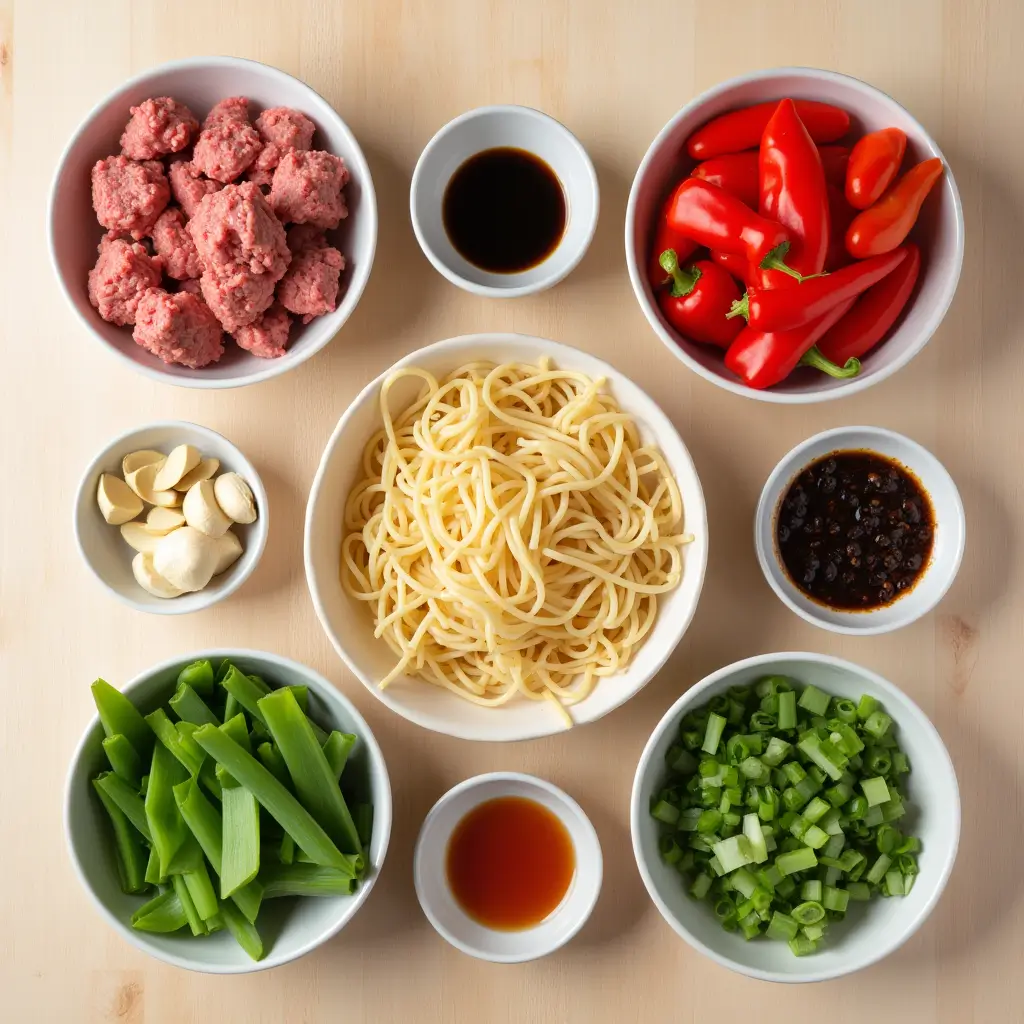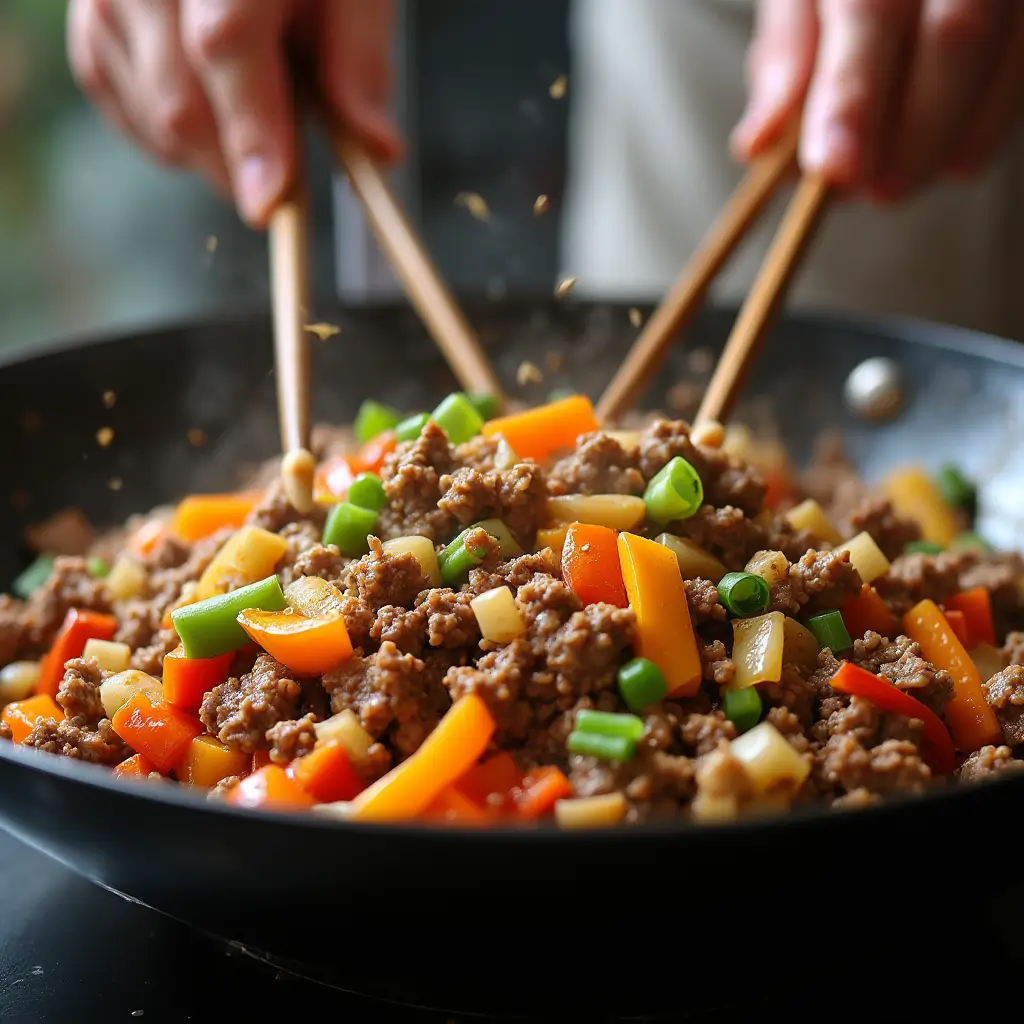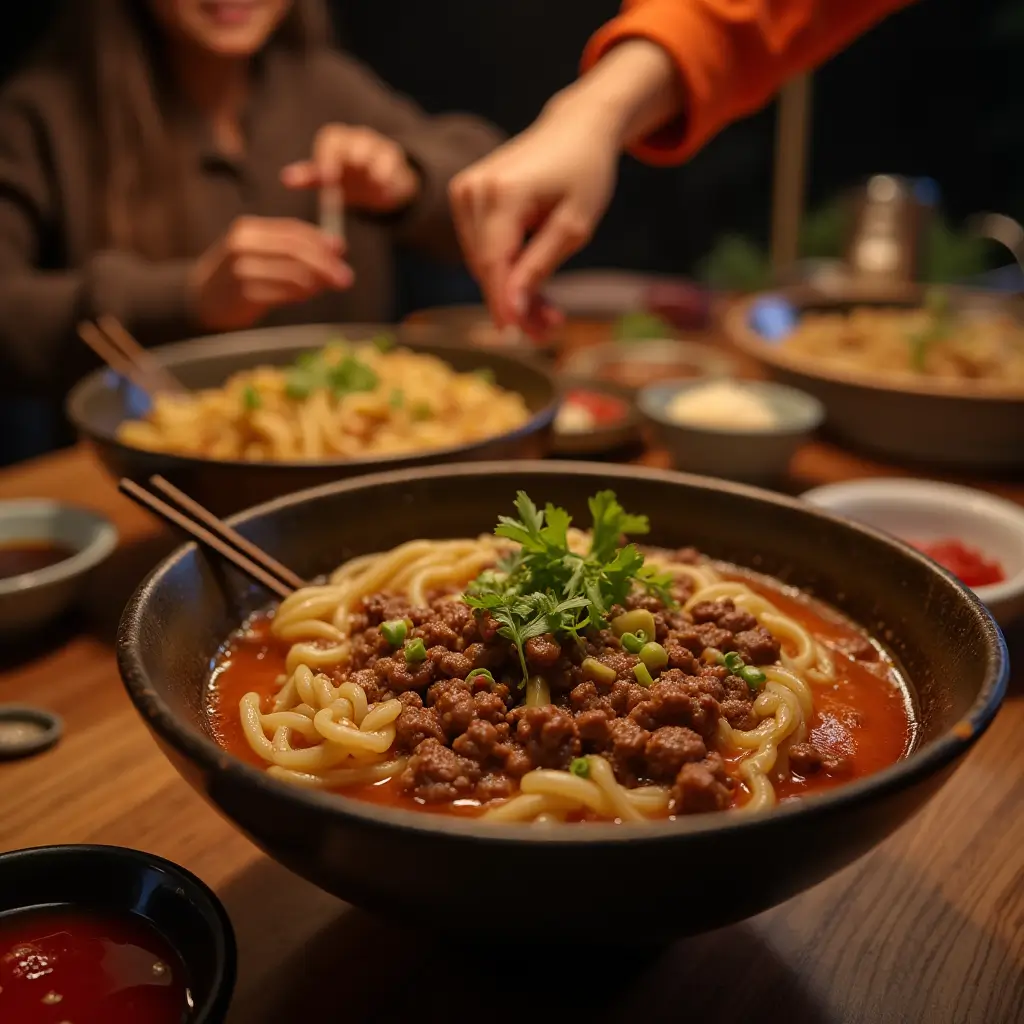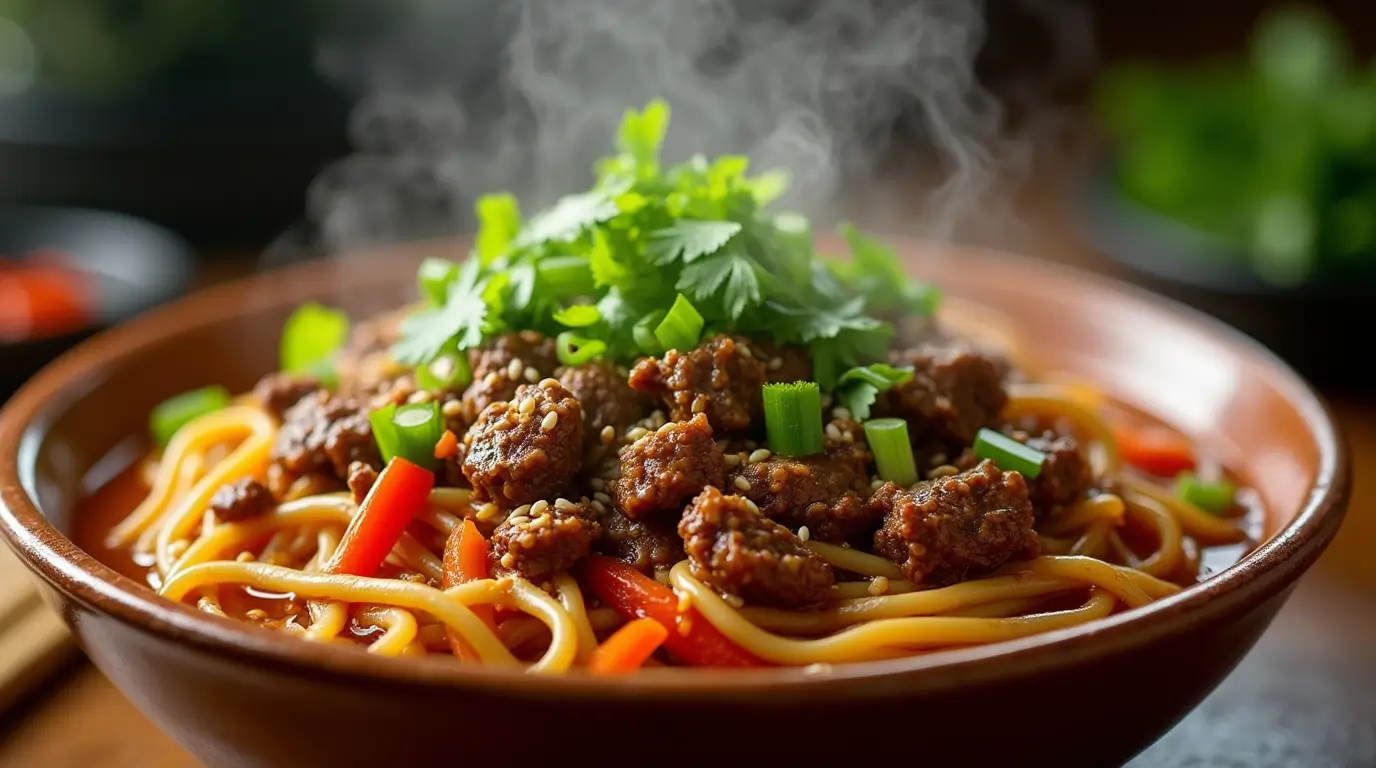Table of Contents
Last night was one of those evenings when I stood in front of my refrigerator, staring blankly at a package of ground beef, wondering what magic I could conjure up for dinner. Sound familiar? Then it hit me those Asian sauces sitting in my pantry door were the answer to transforming ordinary ground beef into something extraordinary. After years of experimenting with Asian flavors in my home kitchen, I’ve discovered that the perfect Asian ground beef noodles can be your weeknight hero meal.
What makes this recipe special isn’t just how incredibly delicious it is (though trust me, it’s mouthwatering), but how these four Asian sauces create layers of flavor that take humble ground beef to restaurant quality status in minutes. Whether you’re a busy parent needing a quick dinner solution or someone looking to expand your culinary horizons beyond the usual pasta night, this recipe will become your new go to.
Let me show you how these simple ingredients combine to create a bowl of noodles that’s savory, slightly sweet, and completely satisfying all in under 30 minutes from start to finish!
Ingredients Breakdown & Substitutions

The Star Players
- 1 lb ground beef The foundation of our dish. Substitute with ground turkey, chicken, or plant based alternatives like Impossible meat for a lighter option.
- 8 oz dried Asian noodles I prefer medium rice noodles, but egg noodles, ramen, or even spaghetti work in a pinch.
- 2 tbsp vegetable oil For stir frying. Avocado oil or peanut oil are excellent alternatives.
The Flavor Powerhouses (The 4 Game Changing Sauces)
- 3 tbsp soy sauce Provides that umami foundation. Use tamari for a gluten free option or coconut aminos for a soy free alternative.
- 2 tbsp oyster sauce Adds richness and depth. Vegetarian mushroom sauce works for a plant based substitute.
- 1 tbsp hoisin sauce Brings sweetness and complexity. In a pinch, mix equal parts plum jam and regular soy sauce.
- 1 tbsp sriracha or chili paste For heat that you can adjust to your preference. Gochujang (Korean chili paste) offers a delicious alternative.
Fresh Components
- 4 cloves garlic, minced Fresh is best, but pre minced works too when you’re in a hurry.
- 1 tbsp fresh ginger, grated Provides that distinctive zing. Substitute with ½ tsp ground ginger if needed.
- 1 medium onion, diced Yellow or white both work well.
- 1 red bell pepper, sliced Adds color and sweetness. Any color bell pepper works.
- 2 cups mixed vegetables I use a mix of snow peas, carrots, and broccoli, but use whatever you have on hand!
Finishing Touches
- 2 green onions, sliced For fresh bite and color.
- ¼ cup cilantro, chopped Omit if you’re in the cilantro tastes like soap camp.
- 1 tbsp sesame oil For that authentic finishing touch.
- 1 tbsp sesame seeds For texture and visual appeal.
What I love about this ingredient list is its flexibility. Have mushrooms instead of bell peppers? Throw them in! Only have ground turkey? That works perfectly too. The magic happens with those four Asian sauces that transform whatever protein and vegetables you have into something special.
Step by Step Instructions with Expert Tips
Prepare your noodles according to package directions. Tip: Cook them 1 minute less than the package states for the perfect al dente texture that will hold up in the stir fry.
Mix your sauce combination. In a small bowl, combine soy sauce, oyster sauce, hoisin sauce, and sriracha. Stir well and set aside. Pro tip: This sauce mixture can be made ahead and stored in the refrigerator for up to a week for even faster meal prep.
Heat a large wok or skillet over medium high heat. Add 1 tbsp of oil and swirl to coat the surface. For best results, get your pan really hot before adding ingredients you want to hear that satisfying sizzle!
Brown the ground beef. Add ground beef to the hot pan and break it into small pieces with a wooden spoon. Cook until no longer pink, about 5-6 minutes. If your beef releases excess fat, drain all but 1 tbsp before proceeding.
Add aromatics. Push the beef to one side of the pan and add remaining 1 tbsp oil. Add garlic, ginger, and onions. Stir fry for 30 seconds until fragrant. Be careful not to burn the garlic it can go from perfect to bitter in seconds!
Incorporate vegetables. Add bell peppers and other vegetables to the pan. Stir fry for 2-3 minutes until vegetables are crisp-tender. If using harder vegetables like carrots, add them before softer ones like snow peas.
Combine everything with the sauce. Pour the prepared sauce mixture over the beef and vegetables. Stir to combine and let it simmer for 1-2 minutes. The sauce should thicken slightly as it simmers this is when the magic happens!
Add the cooked noodles. Toss everything together until the noodles are evenly coated with sauce. If your noodles have been sitting and clumped together, rinse them quickly with warm water before adding.
Finish with flavor boosters. Remove from heat and drizzle with sesame oil, then sprinkle with green onions, cilantro, and sesame seeds. That sesame oil is potent add it off the heat to preserve its aromatic qualities.
Serve immediately in bowls while hot and steaming. For an authentic experience, set out additional sriracha, soy sauce, and chopped cilantro for diners to customize their bowls.
Why This Recipe Is a Must Try
- Ready in under 30 minutes Perfect for busy weeknights when you need dinner on the table fast
- One pan wonder Minimal cleanup means more time enjoying your evening
- Incredibly versatile Works with whatever protein or vegetables you have on hand
- Budget friendly Ground beef stretches further when combined with noodles and vegetables
- Kid approved The mild sweetness from the hoisin sauce makes it appealing to younger palates
- Balanced meal in a bowl Protein, carbs, and veggies all in one satisfying dish
- Restaurant worthy flavor Those four Asian sauces create complexity that tastes like it took hours
- Customizable heat level Add more or less sriracha to suit your spice preference
- Great for meal prep Portions out beautifully for lunch the next day
- Impressive enough for guests Simple to make but looks and tastes sophisticated
Storage, Make Ahead & Freezing Tips
When I make this Asian ground beef noodles recipe, I often double the batch specifically for leftovers. Here’s how I handle storage to maintain maximum flavor:
Refrigerator Storage:
Place cooled leftovers in an airtight container and refrigerate for up to 4 days. The flavors actually develop and deepen overnight, making day two noodles sometimes even better than day one!
Freezer Storage:
While you can freeze this dish for up to 3 months, I’ve found that the texture of the noodles changes slightly upon thawing. If you plan to freeze, I recommend slightly undercooking the noodles and vegetables. Cool completely before transferring to freezer safe containers.
Reheating Method:
For the best texture when reheating, add a splash of water or chicken broth before microwaving covered for 1-2 minutes, stirring halfway through. For stovetop reheating, a quick toss in a hot skillet with a tablespoon of water works wonders to revive the sauces.
Make Ahead Strategy:
If you’re meal prepping, I suggest preparing the sauce mixture and chopping all vegetables up to 2 days in advance. Store them separately in the refrigerator. You can even brown the beef ahead of time. When ready to cook, simply reheat the beef and proceed with the remaining steps.
Leftover Reinvention:
Transform leftovers into an entirely new meal by using them as filling for lettuce wraps, stuffing for bell peppers, or even as a topping for a quick Asian inspired pizza with a drizzle of additional hoisin sauce.
Creative Variations & Serving Ideas

After making this dish countless times, I’ve developed several variations that keep it exciting:
Thai Inspired Twist:
Replace the oyster and hoisin sauces with 2 tablespoons of Thai red curry paste and add a splash of coconut milk at the end for a creamy, spicy variation.
Korean Beef Noodles:
Substitute the sauce mixture with 3 tablespoons of gochujang (Korean chili paste), 2 tablespoons of brown sugar, and 3 tablespoons of soy sauce for a sweet spicy Korean inspired dish.
Crispy Noodle Version:
For textural contrast, fry some of your noodles separately until crispy, then use them as a bed for the saucy beef mixture.
Low Carb Option:
Swap the noodles for spiralized zucchini or shirataki noodles. Just skip the pre cooking step and add them directly to the hot beef mixture to warm through.
Serving Suggestions:
- Offer a side of kimchi or quick pickled vegetables for a tangy contrast
- Serve with a simple miso soup starter
- Pair with a cold Asian beer like Sapporo or Tsingtao
- For a complete experience, offer small dishes of different condiments: extra sriracha, chili oil, pickled ginger, and crushed peanuts
Nutrition Value
| Nutrient | Amount per Serving |
|---|---|
| Calories | 425 |
| Protein | 26g |
| Carbohydrates | 42g |
| Fat | 18g (5g saturated) |
| Fiber | 4g |
| Sugar | 6g |
| Sodium | 870mg |
| Iron | 15% DV |
| Vitamin C | 45% DV |
Serving size: 1/4 of recipe (approximately 1.5 cups)
This Asian ground beef noodle dish offers a well balanced nutritional profile with ample protein from the beef, complex carbohydrates from the noodles, and essential vitamins and minerals from the colorful vegetables. The moderate fat content helps with satiety, while the fiber from vegetables aids digestion.
For those watching sodium intake, you can reduce the sodium content by using low sodium soy sauce or reducing the overall sauce amount. Those following a gluten free diet can easily adapt by using rice noodles and gluten free tamari instead of regular soy sauce.
Nutritional information calculated using the USDA Food Database and standard ingredients. Values may vary depending on specific brands and exact measurements used.
If you enjoyed this recipe, you might also like :
- Cilantro Lime Chicken Salad with Mango Avocado Salsa
- Peanut Butter Rice Crispy Treats
- Alfredo Crock Pot Chicken
- Chicken and Noodles Crock Pot
Expert Tips

After making this recipe countless times (and recovering from a few early disasters), I’ve gathered some invaluable tips:
Don’t overcook your noodles They’ll continue cooking when added to the hot beef mixture. Slightly undercooked is perfect.
High heat is your friend A properly hot wok or skillet creates that restaurant quality sear on your beef and vegetables. If your stovetop isn’t generating enough heat, work in smaller batches to avoid steaming instead of stir frying.
Prep everything before starting This recipe moves quickly once you begin cooking. Having all ingredients measured, chopped, and ready (mise en place) makes the process smooth and stress free.
Season the beef while cooking Add a pinch of salt when browning the beef, even though you’re adding sauces later. This layers the flavor properly.
Balance your sauce After adding the sauce mixture, taste and adjust. Need more salt? Add soy sauce. More sweetness? A touch more hoisin. Too spicy? A teaspoon of honey can balance it.
Don’t skip the sesame oil finish It might seem like a small addition, but that final drizzle of sesame oil adds an aromatic quality that pulls the whole dish together.
Rest before serving Let the finished dish sit off the heat for 1-2 minutes before serving. This allows the noodles to absorb the flavors more fully.
Frequently Asked Questions
How to make Asian beef noodles?
The key to delicious Asian beef noodles is building layers of flavor. Start by browning ground beef, then add aromatics like garlic and ginger, followed by vegetables. The magic comes from combining four essential sauces: soy sauce, oyster sauce, hoisin sauce, and sriracha. Toss with cooked noodles, finish with sesame oil and fresh herbs, and you’ll have an authentic dish in under 30 minutes.
Can you make pancit with ground beef?
Absolutely! While traditional Filipino pancit typically uses sliced meat or seafood, ground beef makes an excellent substitute that absorbs all the delicious flavors. The fine texture of ground beef actually distributes evenly throughout the noodles, ensuring flavor in every bite. Just follow the same cooking method as this recipe but use rice stick noodles and adjust seasonings to include a bit more calamansi or lemon juice for that classic pancit tang.
What is the secret ingredient in Chinese noodles?
The true secret to authentic Chinese noodles isn’t one ingredient but the balance of five key flavors: sweet, sour, salty, bitter, and umami. However, if I had to pinpoint one “secret” ingredient that transforms noodle dishes, it would be a good quality oyster sauce. This thick, savory sauce provides that distinctive restaurant quality umami depth that’s difficult to replicate with other ingredients. A little goes a long way!
How to make beef ramen?
For homemade beef ramen, start by creating a flavorful broth (beef stock simmered with ginger, garlic, and soy sauce). Brown ground beef with the same aromatics used in this noodle recipe. Cook ramen noodles separately, then combine with the beef and broth. Top with a soft boiled egg, green onions, and nori for an authentic touch. For a shortcut version, use this ground beef noodle recipe but increase the sauce amount and add beef broth at the end.
What makes Asian noodles different?
Asian noodles differ from Western pasta in their ingredients, texture, and cooking properties. While Italian pasta typically uses wheat flour and eggs, Asian noodles might be made from rice, mung beans, wheat, or sweet potato starch. This creates distinct textures ranging from chewy (wheat) to slippery (rice) to springy (egg). Asian noodles are often designed to absorb flavorful sauces while maintaining their texture, making them perfect for stir fries like this ground beef recipe.
What to do with ground beef?
Ground beef is incredibly versatile! Beyond the obvious burgers and meatloaf, it shines in global dishes like this Asian noodle recipe, Mexican picadillo, Greek moussaka, or Indian keema. For quick meals, brown it with different seasoning blends (taco, Italian, or the Asian combination in this recipe) and use as a base for grain bowls, stuffed vegetables, or wraps. Pre cook and freeze portions for even faster weeknight meals that just need reheating and pairing with fresh components.
Conclusion
There’s something deeply satisfying about transforming simple ingredients into a meal that feels special, and that’s exactly what these Asian ground beef noodles do. The combination of those four essential sauces creates layers of flavor that belie the dish’s quick preparation time and humble ingredients.
What I love most about this recipe is how it’s become a reliable friend in my kitchen always there when I need a quick solution but never boring or predictable. The flexibility means it evolves with the seasons, with whatever is in my refrigerator, and with my family’s changing tastes.
Have you discovered your own variations or do you have a favorite Asian sauce combination? I’d love to hear how you’ve made this recipe your own! Drop me a comment below with your creative twists or questions.
Until next time, happy cooking!
Don’t forget to subscribe to my newsletter for more globally inspired seafood recipes delivered straight to your inbox, and follow me on PINTEREST TidbitRecipe where I share behind the scenes cooking tips and kitchen experiments!


2 thoughts on “Ground Beef Noodles: Why These 4 Asian Sauces Transform Dinner”
Comments are closed.